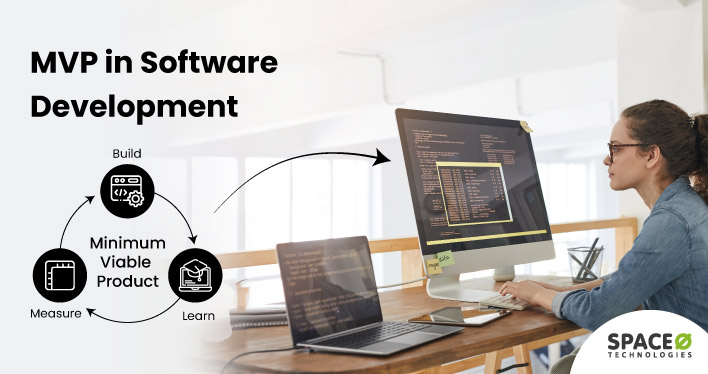- MVP development costs ranges from $15,000 to $140,000, depending on features, technology, and team location.
- Decisions made using an MVP are based on the real user feedback. This enhances your market success potential.
- MVPs offer a low-risk avenue to validate business concepts before major investments.
- Agile and iterative approaches speed up the product development and enable product tweaks based on the customer insights.
Key Takeaways
Looking to launch and test your product idea quickly in the market? Creating an MVP is the perfect solution for you.
As a leading software development company, we specialize in using the latest technologies and tools including programming languages like Python and JavaScript, and frameworks like React and Django. Our team is proficient in Agile methodologies to ensure efficient and iterative delivery of MVP.
To help you with MVP software development, we have written this comprehensive guide. From this guide, you will learn about the steps and benefits involved in developing an MVP, the technologies involved and a few examples of successful MVPs.
Let’s begin with the definition of MVP in Software development.
Table of Contents
- What is a Minimum Viable Product (MVP)?
- What is NOT a Minimum Viable Product?
- Difference Between MVP, Prototype and Proof of Concept
- 6 Steps to Develop an MVP for Your Software
- Cost to Create an MVP
- 3 Key Benefits of MVP Software Development
- 3 Examples of Successful MVPs
- Do You Need an MVP for Your Business?
- 7 Best Practices to Create a Successful MVP Software
- FAQ about MVP Software Development
- Develop Your MVP with Space-O Technologies
What is a Minimum Viable Product (MVP)?
A Minimum Viable Product (MVP) is a simplified version of a product or software that includes only the necessary features and functionalities to meet the client’s primary needs and objectives. By leveraging the MVP methodology, teams can validate product ideas efficiently, reducing risks and optimizing resources.
- Quickly build and release a product.
- Include only the minimum necessary features.
- Satisfy early adopters’ needs and expectations.
The purpose of an MVP is to:
Frank Robinson first defined the term MVP in 2001. Steve Blank and Eric Ries later popularized it within the Lean Startup methodology to validate if a solution meets market demand.
The MVP follows the 80-20 rule (the Pareto Principle), which means you focus on the most important 20% of features that will solve 80% of users’ problems. This way, you can quickly find out if your smallest viable audience (SVA) actually wants your product without spending a lot of time and money.
Let’s understand the MVP concept with an example.
- John Scharffenberger began by making small batches of high-quality chocolate, ensuring each bar met his standards for excellence.
- He chose a farmer’s market as his initial sales channel, allowing him to get immediate customer feedback and adjust his product accordingly.
- The farmer’s market attracted a niche crowd (his smallest viable audience) that appreciated artisanal, high-quality products, making it the perfect testing ground for his chocolate.
- The small-scale operation at the farmer’s market required a low initial investment, reducing financial risks.
- The quality of the product led to word-of-mouth recommendations, eliminating the need for a large marketing budget.
- The initial success and customer validation at the farmer’s market provided the confidence and data to expand the business to a larger scale.
John Scharffenberger’s Bean-to-bar Chocolate Success
Now, let’s cover the difference between MVP, prototyping and proof of concept to help you get a better idea about MVP.
What is NOT a Minimum Viable Product?
Here are some key points to understand what an MVP is not:
- An MVP is not a hastily assembled, incomplete product. It’s carefully planned to meet specific needs.
- An MVP is not for internal testing; it’s designed for real-world use.
- Unlike a PoC, an MVP is not just to show that an idea is possible; it’s a functional, market-ready product.
- An MVP is simplified but should still meet quality standards and offer a good user experience.
It might seem like an MVP is similar to a prototype or a PoC. Let’s understand the differences to clear up any confusion.
Difference Between MVP, Prototyping and Proof of Concept
Here is a table that contains the difference between MVP, prototype and proof of concept.
| Aspects | MVP (Minimum Viable Product) | Prototype | Proof of Concept |
|---|---|---|---|
| Purpose | Deliver a minimal, functional product for early user feedback and validation. | Visualize and test product design and functionality, often without full functionality. | Test the feasibility of a specific technical concept or solution. |
| Example | A ride-sharing app with driver matching, real-time tracking, and basic payment processing to gather user feedback. | A wireframe of an e-commerce website showcasing product selection, cart management, and checkout interactions for user feedback. | A chatbot integrated into customer support, demonstrating its NLP-based query understanding and response capabilities. |
| Functionality | Includes core features to solve a problem or meet a need. | May lack full functionality, focusing on demonstrating specific features. | Proves a technical concept, not a full product with comprehensive features. |
| User Testing | Released to real users for feedback and real-world usage. | Used for internal testing and feedback. | Tested by technical experts to validate chosen technology. |
| Development | Built after a thorough analysis, resulting in a minimal functional product. | Created early in ideation and design, often before extensive coding. | Takes place before full-scale development, focusing on technical feasibility. |
| Duration | Development may take several months. | Can be created relatively quickly, often in a matter of weeks. | Completed in a few weeks or less. |
| Resource Investment | Requires more resources, including development and potential marketing efforts. | Requires moderate resources, primarily for design and early-stage development. | Demands fewer resources, focusing on technical research. |
| Scope | Limited scope with sufficient features for a meaningful user experience. | Broader scope, emphasizing user interface and experience design. | Narrow scope, centered around a specific technical aspect or problem. |
| Success Criteria | Measured by user adoption, feedback, and market viability validation. | Measured by the quality of the user experience and conveying the product’s vision. | Success is determined by the viability and efficiency of the chosen technology. |
Now that you have understood what an MVP is and how it differs from prototypes and PoCs, let’s understand steps to take to develop an MVP for your software development.
How to Develop an MVP for Your Software [6 Steps]
Here are the 6 simple steps to develop an MVP for software development.
Generate and Research Your Idea Thoroughly
When starting with minimum viable product (MVP) development, begin by conducting extensive market research as a crucial step in your project planning. Identify the specific problem you aim to solve and determine your smallest viable audience.
Here are various market research methods you can use.
- Understand the current market, including the trends, market size, and niches.
- Analyze competitors’ products, assessing strengths, weaknesses, and valuable customer feedback.
- Gather direct feedback from the target audience via surveys or conduct one-on-one interviews to better understand their pain points and demands.
- Use analytics tools to collect information about user behavior on existing platforms.
- Conduct a SWOT analysis to identify internal strengths and weaknesses, as well as external opportunities and threats that could impact your MVP.
This initial market research helps validate the viability of your product idea and decide whether there is a genuine need for your software.
Quick Tip:
Do not limit your MVP research to surface-level issues. For example, if users complain about slow performance, research further to understand if it’s due to inefficient coding, server issues, or excessive data processing. This helps in developing a more focused MVP solution.
Define MVP Features with a Focus on Core Functionality
Once you have collected the relevant information by conducting research, you must now define the MVP functionality that addresses the needs of early adopters. Pay close attention to the essential features that directly solve the difficulties you have highlighted. Establish a clear path for MVP development for your startup by classifying the features into “must-haves” and “nice-to-haves”.
For example,
Imagine you are building a SaaS-based project management platform for remote teams. After conducting market research and understanding user pain points, you identify the “must-have” features for your MVP, such as task creation, team collaboration, and real-time notifications. Meanwhile, advanced functionalities like workflow automation or project analytics can be considered as “nice-to-have” features for future updates. This approach helps keep your SaaS MVP development lean, cost-effective, and focused on solving the core problems of your target users.
Choose the Right Development Partner
Working with a software development service provider is often a smart decision in developing MVP. These professionals provide valuable insights, technical experience and necessary development resources. Do some research and select a company with a track record of producing successful MVPs.
To help you choose the right development partner we have prepared the list of top MVP development companies that have a proven track record of developing high quality MVPs. Check this out!
Communicate your vision, objective and key characteristics to the company. The right MVP development partner helps you convert your product idea into a successful MVP staying within the budget and the timeframe.
- Industry Expertise: Space-O Technologies has a rich portfolio of successful MVPs across various industries, including healthcare, fintech, and e-commerce.
- Use of Latest Technologies: Our team is proficient in the latest technologies like Python, JavaScript, React, and Django, ensuring your MVP is built on a robust and scalable platform.
- Customized Solutions: We don’t believe in one-size-fits-all. Our solutions are customized to meet your specific business needs and objectives.
- Time and Budget Efficiency: With our agile development approach, we ensure that your MVP is market-ready within the agreed timeframe and budget.
Why Choose Space-O Technologies for MVP Development?
But don’t just take our word for it. Hear what one of our satisfied clients, Ashton Asherian, has to say about his experience working with Space-O Technologies on his MVP project.
Design User-centric Interfaces and Prototype the User Experience
After partnering with a software development company, the next step is to work with UI and UX designers to create user-centric interfaces. This development process involves creating a wireframe by BA team and a prototype that represents the outline of the layout, placements of the elements and user interaction within the software.
Simultaneously, an interactive prototype is generated that replicates the user experience, offering users to interact with your product’s capacities. These prototypes are essential for collecting early feedback from users and testers. This allows the refining of the user experience before full development starts. This step guarantees that your MVP is not just functional, but also visually appealing and easy to navigate, which increases user satisfaction and adoption rates.
Execute Development and Perform Comprehensive Testing
Now that you have started working with your development team, make sure the team is using Agile development methodology, which breaks the project into smaller phases. Interact frequently with your development team to resolve issues with your MVP. To streamline the MVP development process, teams can leverage various MVP tools, such as prototyping software, project management platforms, and user testing tools. These tools enhance collaboration and speed up iteration cycles.
Meanwhile, comprehensive quality assurance and testing methods must be implemented to guarantee the reliability and security of your final product. These tests include.
- Functional testing is used to determine whether or not the software’s individual functions work properly.
- Regression testing ensures that new updates or changes do not break existing functionalities.
- Load testing is used to figure out how the software product performs under varying levels of user traffic.
- Security testing to detect and address vulnerabilities in order to secure user data.
- User acceptance testing ensures that the software fulfills the expectations of the users.
Launch, Gather User Feedback, and Refine the MVP
Your MVP is now ready for market release. To begin, you should make the MVP available to a small number of users or beta testers and gather valuable feedback in order to analyze user behavior and track statistics. This is valuable information that will assist you in making more accurate decisions about the following version of your software.
Prepare to consistently modify and develop your MVP based on user data, which improves your MVP to better meet user needs and market demand.
Strategic Insight:
When you are planning to launch an MVP, keep the concept of the smallest viable audience (SVA) in mind. Overcomplicating the product or fearing the omission of potential features can lead to an inefficient MVP. Aim for simplicity and focus on meeting the core needs of your SVA.
Let’s discuss the cost associated with the MVP software development.
Want to Develop Your Own MVP?
Our team of experienced developers specializes in MVP development, using cutting-edge tools and technologies like Python, JavaScript, React, and Django.

Space-O Technologies showed genuine interest in the project. The efficient team delivered quality results at a cost-effective price. We wanted to develop a minimum viable product that would be ready for scalability. It was a great experience working with them. We are so happy that we had the chance to meet Space-O. We love their work. Their project management and structure were amazing. The team loved what they were doing. There was passion behind every single piece of work.
How Much Does It Cost to Create a MVP Software?
The average cost to create an MVP ranges from $15,000 to $140,000 or more. The exact cost to create a minimum viable product can vary depending on several factors. These factors include.
- Minimum features and functionality you want to include in your MVP.
- Choice of programming languages, frameworks, and third-party integrations.
- Rates of developers and designers.
- Location of your development team.
- Developing for different platforms like web, mobile, desktop or specific devices.
Now that you know the cost of MVP software development, let’s check the benefits of MVP.
3 Key Benefits of MVP Software Development for Your Business
Here are the 3 key benefits associated with MVP software development.
Optimizes Costs and Maximizes Investment
Instead of pouring resources into a fully-featured product upfront, an MVP offers a lean, cost-effective alternative with just the essential features. This approach saves initial MVP development costs and allows for smarter budget allocation.
As you gather feedback from early users, the MVP model helps you make informed decisions on feature enhancements, ensuring efficient use of resources and avoiding unnecessary expenses.
Accelerates Time-to-Market with Agile Methodology
MVP’s primary objective is to provide a basic yet working product through rapid development. As it works in a short development cycle, this approach is aligned with Agile development methodologies. This helps you to respond rapidly to changing market conditions and user preferences while also speeding up the entire MVP development process.
Mitigates Risks Through Iterative Validation
Traditional development involves high upfront costs and risks. An MVP reduces these risks by letting you test a basic version of your product before full-scale development. You can gather user feedback and make adjustments as needed, ensuring a more refined and lower-risk final product.
Now, let’s discuss the examples of successful MVPs.
3 Examples of Successful MVPs
Here are the 3 examples of successful MVPsoftware development.
Dropbox: A Cloud-based File Storage and Synchronization Service
Dropbox launched its MVP in 2008, which was a short video showing the concept of quickly syncing files across several devices. The software included a basic folder structure, drag-and-drop functionality, and shared folders. Dropbox received over 75,000 sign-ups in one day after releasing the MVP video.
Airbnb: A Global Online Marketplace for Lodging and Traveling.
The Airbnb MVP was introduced in 2007, and it was a simple website where hosts could post their houses and visitors were able to book them. The founders of the project first focused on offering housing for members of a design conference in San Francisco, therefore they personally photographed and listed houses. The first booking for the MVP came three days after the first appearance.
Uber: A Ride-sharing and Transportation Network Platform
Uber began as an MVP in 2010, with a simple smartphone app that enabled potential target audiences to request trips from nearby drivers. The app was initially introduced in San Francisco to link passengers with nearby drivers who used their own cars. The app soon became popular among customers who value convenient and timely services.
Want to Get Your Product to Market Faster?
Create an MVP with us. We have successfully delivered domain-specific MVPs for well-known clients worldwide.
Do you require MVP? Let’s understand.
Do You Need an MVP for Your Business?
Discover whether an MVP is the right strategy for your business venture by evaluating key considerations.
| Who Needs an MVP? | Reasons | Who Doesn’t Need an MVP? | Reasons |
|---|---|---|---|
| Startups | Limited resources, need to validate business idea quickly | Established Companies with Proven Products | Already have market validation and customer base |
| Small Businesses | Want to test a new product or service without full-scale implementation | Niche Artisans | Small-scale, custom products that don’t require market validation |
| Tech Companies | Rapidly evolving markets require quick validation | Franchise Businesses | Business model and demand are already proven |
| Innovators | Need to test a novel idea or technology | Regulatory or Compliance-driven Industries | MVP may not meet legal requirements |
| E-commerce Platforms | Want to test user engagement with a new feature | Large-scale Manufacturing | High setup costs make MVP impractical |
Check out the tips to develop a successful MVP covered in the following section.
7 Best Practices to Create a Successful MVP Software
Here is a list of 7 best practices you need to consider when creating an MVP for your business.
- Define the problem you want to solve and the key value you are aiming to deliver to users.
- Identify and prioritize the critical features needed to solve the user’s needs while avoiding feature bloat.
- Look for the simplest implementation that provides value while reducing the possibility of delays and higher costs.
- Give high priority to tools and technologies that enable rapid development of MVPs.
- Gather feedback early and frequently to better understand your target audience and ensure your MVP is in line with their preferences.
- Define specific success metrics like user engagement, conversion rates, and user satisfaction.
- Before making the MVP available to potential customers, frequently test it to make sure there are no bugs.
So far, you have learned all of the aspects of a minimum viable product. If you’re interested in learning the complete process of building the final software version, we recommend reading our post on how to create software from scratch. If you still have any doubts you can check out the FAQ section.
FAQ about MVP Software Development
Is it necessary to launch an MVP for every software project?
No, it is not necessary to launch an MVP for every software project. Launching an MVP depends on several factors such as the scope of the project, resource limits, market validation demands and competitive environment.
Which are the 3 elements of MVP?
Here are the 3 essential elements of an MVP.
- Core Features: MVP should provide the most basic functionality to address the core problems or needs that the product is designed to solve.
- Minimal Development: MVP is created with minimal resources and least effort, focusing solely on what is necessary to make the product functional and this allows for faster development and testing.
- Rapid User Feedback: MVP is delivered to early adopters as soon as possible to collect feedback and insights, which help evaluate the product’s feasibility.
Develop Your MVP with Space-O Technologies
If you are a startup or an enterprise seeking an affordable and faster approach to developing software products, MVP development is the way to go.
Space-O Technologies provides MVP development services and we have a team of professionals who are committed to delivering effective MVPs that help you meet short deadlines, make the most of limited resources, and transform complex ideas into feasible steps. Our talented team understands the importance of getting your software to market quickly, so we prioritize delivering the software on schedule and under budget. Get in touch with us.



